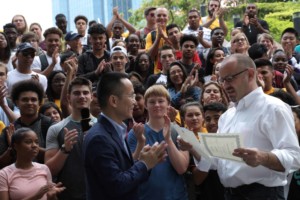Cage-Busting for Smart Cities

By: Frederick Hess
Creating a great education system isn’t just a matter of practice, because rules, regulations, contracts, and cultures can stymie even the most committed educator. But it can’t just be a matter of policy, because what really matters is what educators do in schools—and policies can make people do things but they can’t make them do them well (see school turnarounds, teacher evaluation, et al.). Successful education reform ultimately requires both policy change and also the kind of school, system, and teacher leadership able and willing to deliver on new possibilities.
This all sounds kind of “duh” so far, I know. But here’s where we get stuck. That leadership is not just a matter of “instructional leadership.” It’s not just about curriculum, instruction, and mentoring. It’s also about understanding how to unwind old norms; rethink the use of time, tools, money, and talent; and dismantle the barriers that stymie teachers and leaders. Now, it’s true, as would-be reformers often argue that old policies make it tougher than it should be for school and system leaders to drive improvement. However, it’s also true that leaders have far more freedom to transform, reimagine, and invigorate teaching, learning, and schooling than is widely believed.
The problem is that in selecting, training, socializing, and mentoring leaders, we have unwittingly encouraged “caged” leadership. You need only to talk to school and system leaders or school board members, observe education leadership courses, or read texts by education leadership icons to understand that leaders are expected to succeed via culture, capacity building, coaching, and consensus—no matter the obstacles in their path. Indeed, talking about how to address or trample those obstacles is typically dismissed by leading thinkers on ed leadership as a distraction.
In an attempt to help on this score, a year and a half ago I published Cage-Busting Leadership. In it, I argued that K-12 leaders have much more ability than they think to create great schools and systems. The problem is that they are routinely trapped in “cages” of their own design by urban legends or not knowing what they’re already free to do. The book offered examples of where this is being done and how leaders can do it, and it’s seemed to strike a chord with school and system leaders hungry for that kind of advice.
At the same time, I’ve been curious as to what kind of response Cage-Busting Leadership would get from teachers. After all, in explaining how leaders can empower themselves and do their jobs better, I’m encouraging them to stop living in fear of the contract and to get more ambitious about how to rethink staffing, spending, and schooling. But the teachers didn’t want to quibble about any of that.
Instead, what I mostly heard from teacher leaders was, as one put it, with admirable frankness, “I liked what you said…But [it] has nothing to with my cage. My cage is that my principal is a knucklehead, the district won’t support my program, my association is off in left field, and the people writing the laws don’t give a crap what I think. So, what do you have for me?” It was a really good question. I stammered a bit and then could only say spread my arms and admit, “I’ve got nothing.”
But it’s a key question, and it’s fueled my current book project: The Cage-Busting Teacher, which will be out from Harvard Ed Press next spring. After all, the cage that ensnares teachers is, in many ways, quite different from the one that ensnares school or system administrators, and their tools for escaping it are equally distinct.
Much as we wish it were otherwise, great schooling can’t just be about policies or systems, or even about impassioned leadership—it needs to be about community leaders, district leaders, school leaders, and teachers working to solve problems in smarter, more imaginative ways. And, on that count, cage-busting becomes critical.
Don’t miss or recent hangout with Frederick:
 Frederick M.Hess is an educator, political scientist, and author who serves as director of education policy studies at the American Enterprise Institute. His books include Cage-Busting Leadership, Education Unbound, and Spinning Wheels, and he authors the popular Education Week blog “Rick Hess Straight Up.” A former high school teacher, Hess currently teaches at Rice University and the University of Pennsylvania and serves as executive editor for the influential education journal Education Next.
Frederick M.Hess is an educator, political scientist, and author who serves as director of education policy studies at the American Enterprise Institute. His books include Cage-Busting Leadership, Education Unbound, and Spinning Wheels, and he authors the popular Education Week blog “Rick Hess Straight Up.” A former high school teacher, Hess currently teaches at Rice University and the University of Pennsylvania and serves as executive editor for the influential education journal Education Next.




Denise Foures-Aalbu
Hello Rick,
I totally agree with you regarding Cage-Busting Leadership to move our education system forward so that we are preparing 21st century teachers and students. I am fortunate to have taught with Cage-Busting Teachers who were very concerned about preparing their high school students for the future during a time of technology integration from 1998-2003. We have come a long way in ten years from the beginnings of technology integration which created quite a learning moment for all of us. The most recent implementation problems can teach us to focus on the improvement just as a teacher should focus on the continuous improvement in student learning. I used to teach in "organized chaos" as a French/English High School Teacher. When students will sit on the floor because there are not enough desks a teacher has reached students. It is important that we reach high school students with 21st century skills across all 50 states.Gaining the trust of high school students one becomes a magician!
Regards,
Denise Foures-Aalbu, M.A.
Credentialed Teacher